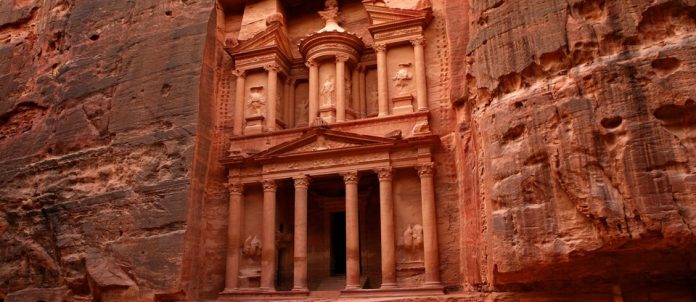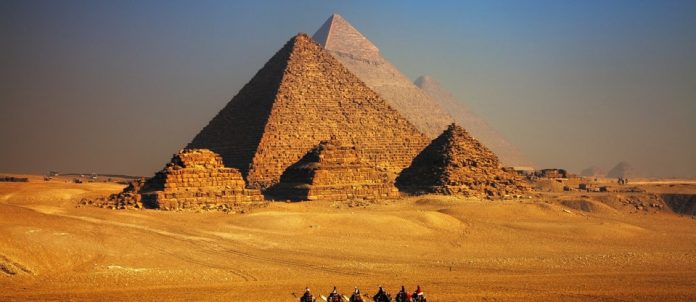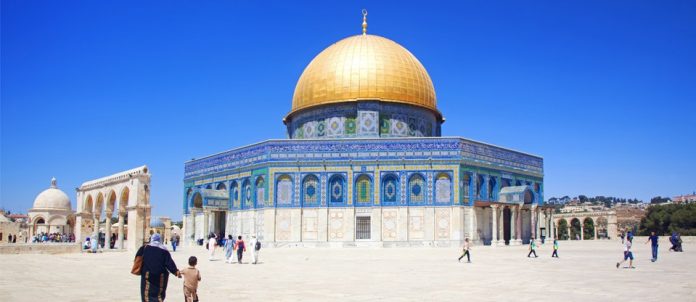The Middle East is a grand epic, a cradle of civilisations and a beautiful, complicated land that’s home to some of the planet’s most hospitable people.
Petra
The spectacular sandstone city of Petra was built in the 3rd century BC by the Nabataeans, who carved palaces, temples, tombs, storerooms and stables from the soft stone cliffs. Today it is a World Heritage Site that needs little introduction; suffice to say, no visit to Jordan is complete without at least two days spent exploring the remarkable Ancient City. It is approached through the adjacent town of Wadi Musa, which is the accommodation and transport hub.
Pyramids of Giza
The last remaining wonder of the ancient world; for nearly 4000 years, the extraordinary shape, impeccable geometry and sheer bulk of the Giza Pyramids have invited the obvious questions: ‘How were we built, and why?’. Centuries of research have given us parts of the answer. Built as massive tombs on the orders of the pharaohs, they were constructed by teams of workers tens-of-thousands strong. Today they stand as an awe-inspiring tribute to the might, organisation and achievements of ancient Egypt.
Ongoing excavations on the Giza Plateau, along with the discovery of a pyramid-builders’ settlement, complete with areas for large-scale food production and medical facilities, have provided more evidence that the workers were not the slaves of Hollywood tradition, but an organised workforce of Egyptian farmers. During the flood season, when the Nile covered their fields, the same farmers could have been redeployed by the highly structured bureaucracy to work on the pharaoh’s tomb. In this way, the Pyramids can almost be seen as an ancient job-creation scheme. And the flood waters made it easier to transport building stone to the site.
But despite the evidence, some still won’t accept that the ancient Egyptians were capable of such achievements. So-called pyramidologists point to the carving and placement of the stones, precise to the millimetre, and argue the numerological significance of the structures’ dimensions as evidence that the Pyramids were constructed by angels or aliens. It’s easy to laugh at these out-there ideas, but when you see the monuments up close, especially inside, you’ll better understand why so many people believe such awesome structures must have unearthly origins.
Most visitors will make a beeline straight to the four most famous sights; the Great Pyramid of Khufu, the Pyramid of Khafre, the Pyramid of Menkaure and the Sphinx. But for those who want to explore further, the desert plateau surrounding the pyramids is littered with tombs, temple ruins and smaller satellite pyramids.
Esfahan
Esfahan is Iran’s top tourist destination for good reason. Its profusion of tree-lined boulevards, Persian gardens and important Islamic buildings gives it a visual appeal unmatched by any other Iranian city, and the many artisans working here underpin its reputation as a living museum of traditional culture. Walking through the historic bazaar, over the picturesque bridges and across the Unesco-listed central square are sure to be highlights of a holiday.
Dome of the Rock
The jewel in the crown of Temple Mount/Al Haram Ash Sharif is the gold-plated Dome of the Rock, the enduring symbol of the city and one of the most photographed buildings on earth. As its name suggests, the dome covers a slab of stone sacred to both the Muslim and Jewish faiths. According to Jewish tradition, it was here that Abraham prepared to sacrifice his son. Islamic tradition has the Prophet Muhammad ascending to heaven from this spot.
Only Muslims can enter the temple, though modestly attired visitors of all creeds can see it from the outside as part of their walk around the plaza.
The building was constructed between 688 and 691 CE under the patronage of the Umayyad caliph Abd Al Malik. His motives were shrewd as well as pious – the caliph wanted to instil a sense of pride in the local Muslim population and keep them loyal to Islam. He also wanted to make a statement to Jews and Christians: Islam was both righteous and all-powerful, so it could build a structure more splendid than any Christian church on a location that was the location of the Jewish Holy of Holies, thus superseding both religions.
Malik had his Byzantine architects take as their model the rotunda of the Holy Sepulchre. But instead of the dark, gloomy interiors or austere stone facades of the Christian structures, their mosque was covered inside and out with a bright confection of mosaics and scrolled verses from the Quran, while the crowning dome was covered in solid gold that shone as a beacon for Islam.
A plaque was laid inside honouring Malik and giving the date of construction. Two hundred years later the Abbasid caliph Al Mamun altered it to claim credit for himself, neglecting to amend the original date. Briefly repurposed as a church under the Crusaders, it promptly became an Islamic shrine again in the 12th century under Saladin. In 1545, Suleiman the Magnificent ordered that the much-weathered exterior mosaics be removed and replaced with tiles. These were again replaced during a major restoration in the 20th century. The original gold dome also disappeared long ago, and the dome you see today is covered with 5000 gold plates donated by the late King Hussein of Jordan. The 80kg of gold cost the king US$8.2 million – he sold one of his homes in London to pay for it.
Essentially, what you see today is the building as conceived by Abd Al Malik. Inside, lying centrally under the 20m-high dome and ringed by a wooden fence, is the rock from which it is said Muhammad began his miraj (ascension to heaven). According to the Quran, Muhammad pushed the stone down with his foot, leaving a footprint on the rock (supposedly still visible in one corner). Jewish tradition also has it that this marks the centre of the world. Steps below the rock lead to a cave known as the Well of Souls, where according to medieval legends the voices of the dead are said to be heard falling into the river of paradise and on to eternity. The mihrab (niche indicating the direction of Mecca) in the sanctuary is said to be the the oldest in the Islamic world.
Note that the whole Temple Mount/Al Haram Ash Sharif complex is often closed to visitors during times of political unrest.
Cappadocia
As if plucked from a whimsical fairytale and set down upon the stark Anatolian plains, Cappadocia is a geological oddity of honeycombed hills and towering boulders of otherworldly beauty. The fantastical topography is matched by the human history here. People have long utilised the region’s soft stone, seeking shelter underground and leaving the countryside scattered with fascinating cavern architecture. The fresco-adorned rock-cut churches of Göreme Open-Air Museum and the subterranean refuges of Derinkuyu and Kaymaklı are the most famous sights, while simply bedding down in one of Cappadocia’s cave hotels is an experience in 21st-century cave living.
Tyre
The storied city of Tyre, once famous across the known world for its purple dye made from murex sea snails (Tyrian purple), has a wonderful seaside location and extensive Roman ruins. It’s a popular holiday destination for Beirutis, with excellent accommodation choices and what are Lebanon’s best, cleanest beaches; you might even swim with turtles.



